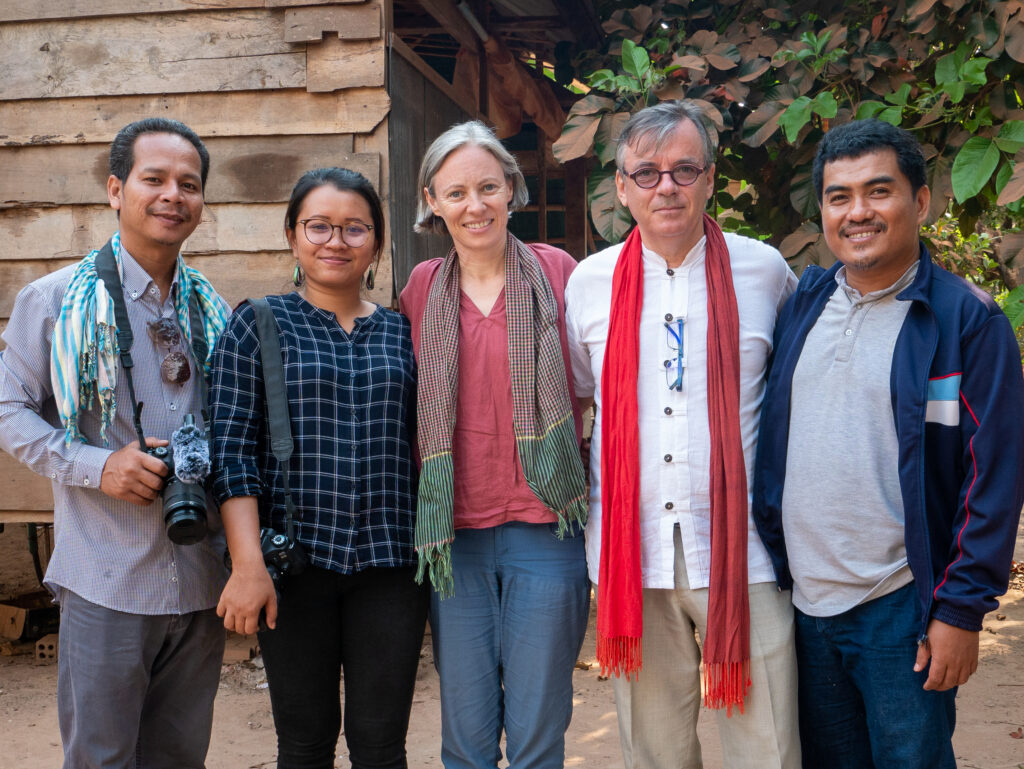PI: Catherine Grant | Collaborators: Song Seng, Patrick Kersale | Project ID: 2019SG02 | Host Institution: Griffith University
In collaboration with non-governmental non-profit “Cambodian Living Arts” (CLA), this project documented and made available for future generations the instrument and instrument-making practices of the Cambodian mouth harp (commonly “Jew’s harp”) Angkuoch. The Angkuoch is highly endangered both as an instrument and performance practice, with fewer than ten instrument-makers believed to remain across Cambodia. Running from 1 October 2019 to 30 September 2020, for the first time this project documented in depth the process of making the instrument. Working predominantly with five participants in two rural village communities, it documented Angkuoch and its production cycle as found in Siem Riep province, focussing on two types of Angkuoch: those made of bamboo (Angkuoch russey) and of iron (Angkuoch daek).
អ្នកចេះធ្វើអង្កួចដែលប្រហែលជាងតិចជាងដប់នាក់ប៉ុណ្ណោះដែលត្រូវបានគេស្គាល់ទូទាំងប្រទេសកម្ពុជា ហើយរបៀបនៃការធ្វើអង្កួចនេះមិនទាន់ត្រូវបានបានចងក្រងឱ្យស៊ីជម្រៅនៅឡើយ។ ដោយសហការជាមួយអង្គការសិល្បៈខ្មែរអមតៈ និងអ្នកចេះធ្វើអង្កួចនិងអ្នកលេងបីនាក់ គម្រោងមួយនេះបានចងក្រងអំពីសង្គមវប្បធម៍នៃឧបករណ៍អង្កួច និងរបៀបធ្វើអង្កួច នៅភូមិចំនួនពីរក្នុងខេត្តសៀមរាប។ លទ្ធផលនៃគម្រោងរួមមាន៖ វីដេអូឯកសាររយៈពេល២០នាទី ដែលធ្វើឡើងជាភាសាខ្មែរដែលមានអក្សររត់ជាភាសាអង់គ្លេស ហើយវីដេអូនេះនឹងយកមកផ្សព្វផ្សាយជាសាធារណៈតាមរយៈ EMKP Digital Repository of the British Museum (UK) និងបណ្ណសារដ្ឋានសំខាន់ៗពីរនៅកម្ពុជាគឺ មជ្ឈមណ្ឌលសោតទស្សន៍បុប្ផាណា និង មជ្ឈមណ្ឌលបេតិកភណ្ឌ។ គម្រោងនេះគាំទ្រដោយ Endangered Material Knowledge Program នៃសារមន្ទីរចក្រភពអង់គ្លេស។
ក្រុមអ្នកស្រាវជ្រាវមាន៖ លោកស្រី ខាត់ធឺរីន ហ្ក្រាន លោក សុង សេង លោក ប៉ាទ្រីក ឃើសាឡេ
“Angkuoch”: Rediscovering the Cambodian Jew’s Harp (project video documentary).
The project repository on Figshare contains the edited project data, including more than 10 hours of video (see the examples below of community members playing the Angkuoch 0253 and other instruments 0052 ) audios of different interviews, and instrument playing (see for example 0253), over 200 photographs (including photos of the Angkuoch 0022 and community members who played a part in the making process 0176) nearly 400 pages of text (including interviews 0037 and project fieldwork notes 0005) and an 18-minute video documentary 0256 (a sample of which has been shared above). The project also generated print media articles, radio interviews, blog posts, a 24-page bilingual print and online brochure, seminars and presentations, and scholarly publications.
In addition to the documentary and scholarly outcomes, the project has also generated several socio-cultural outcomes from which both the local community and the British Museum have benefited. In this regard, the EMKP funded project has allowed the identification of the likely maker of a Cambodian mouth harp As1966,11.5 kept in the museum collections. The harp was donated in 1966 without attribution and for the last five decades had no makers associated with it. Project findings strongly suggested that the maker is MONG Koeuy, whose son, wife, and daughter provided video-recorded statements about the object (Assets 206-217, 252a-d). At the time of writing (August 2021), the British Museum is underway with the process of appending to its catalogue entry for this instrument due acknowledgement of Mong Koeuy, as well as a detailed statement by Project Leader Grant about this finding. Other positive outcomes include the revival of local Angkuoch related activity, the first in-depth documentation of making and playing Angkuoch, made freely publicly available via the project repository, the acquisition by the British Museum of two Angkuoch for its collection 2020,3017.2 and 2020,3017.1 and the training, capacity-building, and career progression of the Project Team members, all of which are further explained in the project data guide.
A curated selection of assets from the collection has been provided below as a small sample of the type of assets that can be found in the repository, as well as their content, format, and the metadata provided. The documentation generated by the project has been published under a CC BY-NC-SA 4.0 license and can be consulted and downloaded freely including a guide to the dataset which explains the different formats, sizes, and the ID attribution process of the assets, and a metadata spreadsheet with all the metadata information which was collated following the Material Culture Ethnography Metadata Schema (MCEMS),
Curated collection of assets from the project repository by Catherine Grant
Keuy Ratha plays angkuoch russey. Video: Thon Dika, 22 January 2020.
Bamboo angkuoch-maker Krak Chi playing one of his instruments. Video: Thon Dika, 5 January 2020.
Photograph of two instruments made for the project, subsequently acquired by the British Museum. Angkuoch russey by Chi Monivong and angkuoch daek by Bin Song. Photo: Catherine Grant, 6 March 2020.
Photograph of iron angkuoch-maker Bin Song inspecting one of his instruments, with wife in background. Photo: Catherine Grant, 8 January 2020.
Transcript in Khmer and translation in English of interview (Part 1) conducted by Say Tola with bamboo angkuoch-maker Krak Chi. 4 January 2020.
Project fieldwork notes by Catherine Grant and Say Tola.
Project Team

Angkuoch Project Research Team. Left to right: THON Dika, SAY Tola, Catherine GRANT, Patrick KERSALE, SONG Seng. (Photo: MITH Narong, 11 January 2020) • ក្រុមអ្នកស្រាវជ្រាវអង្កួច។ ពេឆ្វេងទៅស្តាំ ថន ដីកា, សាយ តុលា, ខាត់ធឺរីន ហ្ក្រាន, ប៉ាទ្រីក ឃើសាឡេ, សុង សេង។ រូបថតដោយ៖ មិត្ត ណារុង, ថ្ងៃទី ១១ ខែមករា ឆ្នាំ២០២០។.
